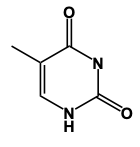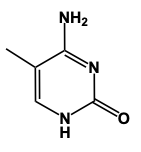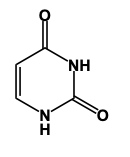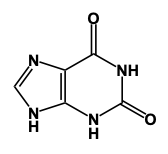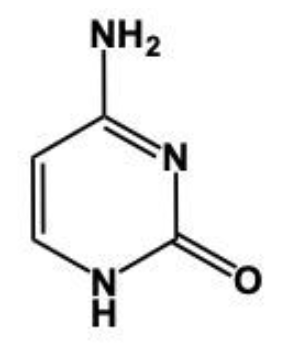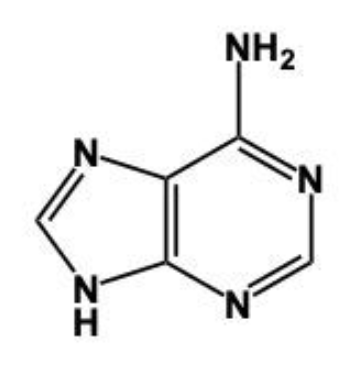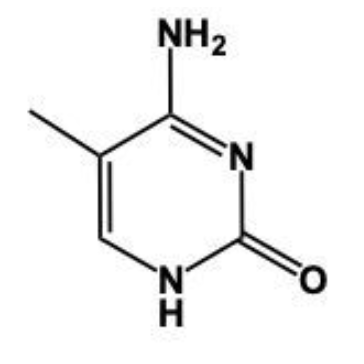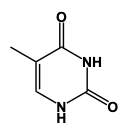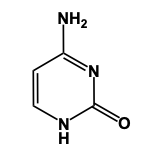Hey, everyone. So when it comes to nitrogenous bases, we're going to say there are 5 different nitrogenous bases that are grouped into 2 categories. We're going to have our pyrimidines versus our purines. Now, pyrimidines, these are our single-ringed molecules, and our purines are our double-ringed molecules. Now, here we have memory tools to help us remember which is which. When it comes to our Pyrimidines, we're going to have our Cytosine, our Thymine, and our Uracil. When it comes to Thymine, this is only found within DNA and Uracil is only found within RNA. Later on, we'll talk about their given structures. Right now, we're only caring about grouping them. So these 3 nitrogen spaces all are single, molecules, single-ringed molecules. And our memory tool here is that creepy tombs under pyramids. Pyramids, remidines, creepy for cytosine, tombs for thymine, and under for uracil. Here, their one-letter abbreviations would be c, t, u. On the other side, we have our purines, which are our adenine and guanine, so a and g. So it's 2 rings fused together when it comes to these structures, and our memory tool here is pure as gold. Pure for purines, s for adenine, and then g for gold guanine. Alright. So just remember, we have our creepy tombs under pyramids and pure as gold to help us group our 5 nitrogenous bases into their 2 categories, being either single-ringed molecules or double-ringed molecules.
- 1. A Review of General Chemistry5h 5m
- Summary23m
- Intro to Organic Chemistry5m
- Atomic Structure16m
- Wave Function9m
- Molecular Orbitals17m
- Sigma and Pi Bonds9m
- Octet Rule12m
- Bonding Preferences12m
- Formal Charges6m
- Skeletal Structure14m
- Lewis Structure20m
- Condensed Structural Formula15m
- Degrees of Unsaturation15m
- Constitutional Isomers14m
- Resonance Structures46m
- Hybridization23m
- Molecular Geometry16m
- Electronegativity22m
- 2. Molecular Representations1h 14m
- 3. Acids and Bases2h 46m
- 4. Alkanes and Cycloalkanes4h 19m
- IUPAC Naming29m
- Alkyl Groups13m
- Naming Cycloalkanes10m
- Naming Bicyclic Compounds10m
- Naming Alkyl Halides7m
- Naming Alkenes3m
- Naming Alcohols8m
- Naming Amines15m
- Cis vs Trans21m
- Conformational Isomers13m
- Newman Projections14m
- Drawing Newman Projections16m
- Barrier To Rotation7m
- Ring Strain8m
- Axial vs Equatorial7m
- Cis vs Trans Conformations4m
- Equatorial Preference14m
- Chair Flip9m
- Calculating Energy Difference Between Chair Conformations17m
- A-Values17m
- Decalin7m
- 5. Chirality3h 39m
- Constitutional Isomers vs. Stereoisomers9m
- Chirality12m
- Test 1:Plane of Symmetry7m
- Test 2:Stereocenter Test17m
- R and S Configuration43m
- Enantiomers vs. Diastereomers13m
- Atropisomers9m
- Meso Compound12m
- Test 3:Disubstituted Cycloalkanes13m
- What is the Relationship Between Isomers?16m
- Fischer Projection10m
- R and S of Fischer Projections7m
- Optical Activity5m
- Enantiomeric Excess20m
- Calculations with Enantiomeric Percentages11m
- Non-Carbon Chiral Centers8m
- 6. Thermodynamics and Kinetics1h 22m
- 7. Substitution Reactions1h 48m
- 8. Elimination Reactions2h 30m
- 9. Alkenes and Alkynes2h 9m
- 10. Addition Reactions3h 18m
- Addition Reaction6m
- Markovnikov5m
- Hydrohalogenation6m
- Acid-Catalyzed Hydration17m
- Oxymercuration15m
- Hydroboration26m
- Hydrogenation6m
- Halogenation6m
- Halohydrin12m
- Carbene12m
- Epoxidation8m
- Epoxide Reactions9m
- Dihydroxylation8m
- Ozonolysis7m
- Ozonolysis Full Mechanism24m
- Oxidative Cleavage3m
- Alkyne Oxidative Cleavage6m
- Alkyne Hydrohalogenation3m
- Alkyne Halogenation2m
- Alkyne Hydration6m
- Alkyne Hydroboration2m
- 11. Radical Reactions1h 58m
- 12. Alcohols, Ethers, Epoxides and Thiols2h 42m
- Alcohol Nomenclature4m
- Naming Ethers6m
- Naming Epoxides18m
- Naming Thiols11m
- Alcohol Synthesis7m
- Leaving Group Conversions - Using HX11m
- Leaving Group Conversions - SOCl2 and PBr313m
- Leaving Group Conversions - Sulfonyl Chlorides7m
- Leaving Group Conversions Summary4m
- Williamson Ether Synthesis3m
- Making Ethers - Alkoxymercuration4m
- Making Ethers - Alcohol Condensation4m
- Making Ethers - Acid-Catalyzed Alkoxylation4m
- Making Ethers - Cumulative Practice10m
- Ether Cleavage8m
- Alcohol Protecting Groups3m
- t-Butyl Ether Protecting Groups5m
- Silyl Ether Protecting Groups10m
- Sharpless Epoxidation9m
- Thiol Reactions6m
- Sulfide Oxidation4m
- 13. Alcohols and Carbonyl Compounds2h 17m
- 14. Synthetic Techniques1h 26m
- 15. Analytical Techniques:IR, NMR, Mass Spect7h 3m
- Purpose of Analytical Techniques5m
- Infrared Spectroscopy16m
- Infrared Spectroscopy Table31m
- IR Spect:Drawing Spectra40m
- IR Spect:Extra Practice26m
- NMR Spectroscopy10m
- 1H NMR:Number of Signals26m
- 1H NMR:Q-Test26m
- 1H NMR:E/Z Diastereoisomerism8m
- H NMR Table24m
- 1H NMR:Spin-Splitting (N + 1) Rule22m
- 1H NMR:Spin-Splitting Simple Tree Diagrams11m
- 1H NMR:Spin-Splitting Complex Tree Diagrams12m
- 1H NMR:Spin-Splitting Patterns8m
- NMR Integration18m
- NMR Practice14m
- Carbon NMR4m
- Structure Determination without Mass Spect47m
- Mass Spectrometry12m
- Mass Spect:Fragmentation28m
- Mass Spect:Isotopes27m
- 16. Conjugated Systems6h 13m
- Conjugation Chemistry13m
- Stability of Conjugated Intermediates4m
- Allylic Halogenation12m
- Reactions at the Allylic Position39m
- Conjugated Hydrohalogenation (1,2 vs 1,4 addition)26m
- Diels-Alder Reaction9m
- Diels-Alder Forming Bridged Products11m
- Diels-Alder Retrosynthesis8m
- Molecular Orbital Theory9m
- Drawing Atomic Orbitals6m
- Drawing Molecular Orbitals17m
- HOMO LUMO4m
- Orbital Diagram:3-atoms- Allylic Ions13m
- Orbital Diagram:4-atoms- 1,3-butadiene11m
- Orbital Diagram:5-atoms- Allylic Ions10m
- Orbital Diagram:6-atoms- 1,3,5-hexatriene13m
- Orbital Diagram:Excited States4m
- Pericyclic Reaction10m
- Thermal Cycloaddition Reactions26m
- Photochemical Cycloaddition Reactions26m
- Thermal Electrocyclic Reactions14m
- Photochemical Electrocyclic Reactions10m
- Cumulative Electrocyclic Problems25m
- Sigmatropic Rearrangement17m
- Cope Rearrangement9m
- Claisen Rearrangement15m
- 17. Ultraviolet Spectroscopy51m
- 18. Aromaticity2h 34m
- 19. Reactions of Aromatics: EAS and Beyond5h 1m
- Electrophilic Aromatic Substitution9m
- Benzene Reactions11m
- EAS:Halogenation Mechanism6m
- EAS:Nitration Mechanism9m
- EAS:Friedel-Crafts Alkylation Mechanism6m
- EAS:Friedel-Crafts Acylation Mechanism5m
- EAS:Any Carbocation Mechanism7m
- Electron Withdrawing Groups22m
- EAS:Ortho vs. Para Positions4m
- Acylation of Aniline9m
- Limitations of Friedel-Crafts Alkyation19m
- Advantages of Friedel-Crafts Acylation6m
- Blocking Groups - Sulfonic Acid12m
- EAS:Synergistic and Competitive Groups13m
- Side-Chain Halogenation6m
- Side-Chain Oxidation4m
- Reactions at Benzylic Positions31m
- Birch Reduction10m
- EAS:Sequence Groups4m
- EAS:Retrosynthesis29m
- Diazo Replacement Reactions6m
- Diazo Sequence Groups5m
- Diazo Retrosynthesis13m
- Nucleophilic Aromatic Substitution28m
- Benzyne16m
- 20. Phenols55m
- 21. Aldehydes and Ketones: Nucleophilic Addition4h 56m
- Naming Aldehydes8m
- Naming Ketones7m
- Oxidizing and Reducing Agents9m
- Oxidation of Alcohols28m
- Ozonolysis7m
- DIBAL5m
- Alkyne Hydration9m
- Nucleophilic Addition8m
- Cyanohydrin11m
- Organometallics on Ketones19m
- Overview of Nucleophilic Addition of Solvents13m
- Hydrates6m
- Hemiacetal9m
- Acetal12m
- Acetal Protecting Group16m
- Thioacetal6m
- Imine vs Enamine15m
- Addition of Amine Derivatives5m
- Wolff Kishner Reduction7m
- Baeyer-Villiger Oxidation39m
- Acid Chloride to Ketone7m
- Nitrile to Ketone9m
- Wittig Reaction18m
- Ketone and Aldehyde Synthesis Reactions14m
- 22. Carboxylic Acid Derivatives: NAS2h 51m
- Carboxylic Acid Derivatives7m
- Naming Carboxylic Acids9m
- Diacid Nomenclature6m
- Naming Esters5m
- Naming Nitriles3m
- Acid Chloride Nomenclature5m
- Naming Anhydrides7m
- Naming Amides5m
- Nucleophilic Acyl Substitution18m
- Carboxylic Acid to Acid Chloride6m
- Fischer Esterification5m
- Acid-Catalyzed Ester Hydrolysis4m
- Saponification3m
- Transesterification5m
- Lactones, Lactams and Cyclization Reactions10m
- Carboxylation5m
- Decarboxylation Mechanism14m
- Review of Nitriles46m
- 23. The Chemistry of Thioesters, Phophate Ester and Phosphate Anhydrides1h 10m
- 24. Enolate Chemistry: Reactions at the Alpha-Carbon1h 53m
- Tautomerization9m
- Tautomers of Dicarbonyl Compounds6m
- Enolate4m
- Acid-Catalyzed Alpha-Halogentation4m
- Base-Catalyzed Alpha-Halogentation3m
- Haloform Reaction8m
- Hell-Volhard-Zelinski Reaction3m
- Overview of Alpha-Alkylations and Acylations5m
- Enolate Alkylation and Acylation12m
- Enamine Alkylation and Acylation16m
- Beta-Dicarbonyl Synthesis Pathway7m
- Acetoacetic Ester Synthesis13m
- Malonic Ester Synthesis15m
- 25. Condensation Chemistry2h 9m
- 26. Amines1h 43m
- 27. Heterocycles2h 0m
- Nomenclature of Heterocycles15m
- Acid-Base Properties of Nitrogen Heterocycles10m
- Reactions of Pyrrole, Furan, and Thiophene13m
- Directing Effects in Substituted Pyrroles, Furans, and Thiophenes16m
- Addition Reactions of Furan8m
- EAS Reactions of Pyridine17m
- SNAr Reactions of Pyridine18m
- Side-Chain Reactions of Substituted Pyridines20m
- 28. Carbohydrates5h 53m
- Monosaccharide20m
- Monosaccharides - D and L Isomerism9m
- Monosaccharides - Drawing Fischer Projections18m
- Monosaccharides - Common Structures6m
- Monosaccharides - Forming Cyclic Hemiacetals12m
- Monosaccharides - Cyclization18m
- Monosaccharides - Haworth Projections13m
- Mutarotation11m
- Epimerization9m
- Monosaccharides - Aldose-Ketose Rearrangement8m
- Monosaccharides - Alkylation10m
- Monosaccharides - Acylation7m
- Glycoside6m
- Monosaccharides - N-Glycosides18m
- Monosaccharides - Reduction (Alditols)12m
- Monosaccharides - Weak Oxidation (Aldonic Acid)7m
- Reducing Sugars23m
- Monosaccharides - Strong Oxidation (Aldaric Acid)11m
- Monosaccharides - Oxidative Cleavage27m
- Monosaccharides - Osazones10m
- Monosaccharides - Kiliani-Fischer23m
- Monosaccharides - Wohl Degradation12m
- Monosaccharides - Ruff Degradation12m
- Disaccharide30m
- Polysaccharide11m
- 29. Amino Acids3h 20m
- Proteins and Amino Acids19m
- L and D Amino Acids14m
- Polar Amino Acids14m
- Amino Acid Chart18m
- Acid-Base Properties of Amino Acids33m
- Isoelectric Point14m
- Amino Acid Synthesis: HVZ Method12m
- Synthesis of Amino Acids: Acetamidomalonic Ester Synthesis16m
- Synthesis of Amino Acids: N-Phthalimidomalonic Ester Synthesis13m
- Synthesis of Amino Acids: Strecker Synthesis13m
- Reactions of Amino Acids: Esterification7m
- Reactions of Amino Acids: Acylation3m
- Reactions of Amino Acids: Hydrogenolysis6m
- Reactions of Amino Acids: Ninhydrin Test11m
- 30. Peptides and Proteins2h 42m
- Peptides12m
- Primary Protein Structure4m
- Secondary Protein Structure17m
- Tertiary Protein Structure11m
- Disulfide Bonds17m
- Quaternary Protein Structure10m
- Summary of Protein Structure7m
- Intro to Peptide Sequencing2m
- Peptide Sequencing: Partial Hydrolysis25m
- Peptide Sequencing: Partial Hydrolysis with Cyanogen Bromide7m
- Peptide Sequencing: Edman Degradation28m
- Merrifield Solid-Phase Peptide Synthesis18m
- 32. Lipids 2h 50m
- 34. Nucleic Acids1h 32m
- 35. Transition Metals5h 33m
- Electron Configuration of Elements45m
- Coordination Complexes20m
- Ligands24m
- Electron Counting10m
- The 18 and 16 Electron Rule13m
- Cross-Coupling General Reactions40m
- Heck Reaction40m
- Stille Reaction13m
- Suzuki Reaction25m
- Sonogashira Coupling Reaction17m
- Fukuyama Coupling Reaction15m
- Kumada Coupling Reaction13m
- Negishi Coupling Reaction16m
- Buchwald-Hartwig Amination Reaction19m
- Eglinton Reaction17m
- 36. Synthetic Polymers1h 49m
- Introduction to Polymers6m
- Chain-Growth Polymers10m
- Radical Polymerization15m
- Cationic Polymerization8m
- Anionic Polymerization8m
- Polymer Stereochemistry3m
- Ziegler-Natta Polymerization4m
- Copolymers6m
- Step-Growth Polymers11m
- Step-Growth Polymers: Urethane6m
- Step-Growth Polymers: Polyurethane Mechanism10m
- Step-Growth Polymers: Epoxy Resin8m
- Polymers Structure and Properties8m
Nitrogenous Bases - Online Tutor, Practice Problems & Exam Prep
 Created using AI
Created using AINitrogenous bases are categorized into pyrimidines and purines. Pyrimidines, which include cytosine (C), thymine (T), and uracil (U), are single-ringed structures. Purines, adenine (A) and guanine (G), feature double-ringed structures. Pyrimidines can be remembered with "creepy tombs under pyramids," while purines relate to "pure as gold." The structures of these bases are essential for understanding nucleic acids, with uracil serving as a foundation for thymine and cytosine modifications. Recognizing these structures aids in grasping the complexities of DNA and RNA.
Nitrogenous Bases Concept 1
Video transcript
Nitrogenous Bases Example 1
Video transcript
So in this example, it says label each nitrogen space as a pyrimidine (p y) or a purine (p u). So remember when it comes to our pyrimidines, we're going to say here "creepy tombs under pyramids". So here, if we say these represent our pyrimidines, "creepy" stands for cytosine. So this will be p y. "Tombs" is for thymine. So p y. "Under" is for uracil. So p y. And then for purines, we're going to say purines are "pure as gold". So our purines, "pure" is for adenine or adenine. So here this would be p u. And then, "gold" is for guanine. So this is how we label each of the following nitrogenous bases based on these two memory tools. We can group them into pyrimidines or purines.
The four nitrogenous bases commonly found in DNA are:
Uracil, cytosine, guanine, thymine.
Adenine, thymine, cytosine, uracil.
Uracil, adenine, cytosine, guanine.
Adenine, thymine, cytosine, guanine.
None are correct.
Nitrogenous Bases Concept 2
Video transcript
In this beetle, we'll learn some tricks to help us remember the structures of different pyrimidines. So here, first of all, when we say pyrimidine, this is the general structure of pyrimidine. The 3 pyrimidines that we have are just modifications to this original structure, and it all begins with Uracil. Uracil here has its 2 nitrogens just like pyrimidine does, but it also has 2 carbonyl groups. So we have a double bond O here and a double bond O here. Now, here, we had a double bond, but we can no longer have a double bond here because then this carbon would be making 5 bonds. So that's not allowed. But nitrogen ideally wants to make 3 bonds. To do that, it would have to be connected to a hydrogen. So, it'd have a connection to the 2 carbons and then the 3rd bond will be to the hydrogen. We went into the same issue here with this bottom nitrogen. We can't have a double bond like we have here because then this carbonyl carbon will be making 5 bonds. Carbon can only go up to 4. So for nitrogen to reach its 3 bonds, its ideal number of bonds, it'd be connected to a hydrogen. So this represents the structure of uracil. So just remember, we have our 2 carbonyls here and then each of the nitrogens to make their 3rd bond connects to a hydrogen.
Now, here uracil, the other two pyrimidines are just modifications of this, thymine, and cytosine. Thymine and uracil are very similar in structure, the only difference is that there's a methyl group involved. The methyl group would be right here, and then we'd still have our 2 carbonyls here and here, and our nitrogens would still have an H each. So this is thymine.
Cytosine is a little bit trickier. But just remember, we're going to say, cytosine is cytosine amine group. So when we see amine group, kind of have a moment like, oh gosh. Here it goes. Si amine group. So what does this mean? Well, we're going to still have our carbonyl here. We're going to still have an H on this nitrogen here. But now, we're still going to possess this double bond just like this nitrogen here possesses a double bond. It's making its 3 bonds, so it doesn't need an H on it. And then, cytosine amine. Amin. Right? It's pronounced the same way as an amine, the functional group amine, which we know is an NH2 group. So instead of having 2 carbonyls, we have 1 carbonyl and 1 NH2 group right here. So this represents our cytosine. So just remember, this is the starting structure of pyrimidine. The 3 pyrimidines are just modifications of it. It all starts with uracil and from there, from uracil, you can adapt it to give us thymine or to give us cytosine. This is the key to remembering the structures of these different types of nitrogenous bases.
Nitrogenous Bases Example 2
Video transcript
Here in this example question, it says, "Complete a structure of thymine base." So remember, to draw thymine, we need to remember the structure for uracil. If we can remember the structure for uracil, we just adapt it to give us thymine. Now, first of all, remember that our pyrimidines have this basic structure involved. We have our nitrogens here. This will make a double bond, double bond here, and double bond here. This is the general structure of a pyrimidine. For uracil, all we do now is adapt this structure; we'd have 2 carbonyl groups here and here. We'd still have our double bond here. The nitrogens still need to make 3 bonds, and they do that by adding an H to each one. This would be uracil. To get thymine, just remember methyl because it's connected to the thymine. So here with that, just realize we have this similar structure. The difference now is we're going to add a methyl group. So we'd still have a double bond here. We'd have our 2 carbonyls still. Each nitrogen would still have an H. Methyl for thymine. The methyl will come off of this carbon here. So this will represent the structure for thymine. Remember, we were able to do it by first remembering what a pyrimidine looks like in terms of this structure, then modifying this structure to uracil. And then just remember, if you know uracil, thymine is almost the same, except we have a methyl involved. So, add the methyl group to the appropriate carbonyl. And there you have it, thymine represents what we have within the box.
Nitrogenous Bases Concept 3
Video transcript
In this video, we'll talk about some tricks that we can remember in order to draw purine structures. Now, a purine, the base form, is this. We have two rings fused together, and we see that we have four nitrogens embedded within those rings. Now for adenine, remember the structure of adenine, just remember adenine, ad amine, and amine is an NH2 group. Here we're just going to add an NH2 group to this structure. So here we'd still have a double bond on this nitrogen, and we would add our amine to this carbon right here, our NH2 group. And this will represent adenine.
Now, guanine, if you remember the structure of guanine, we're going to say go first. This red oxygen indicates that we have a carbonyl. And there goes our red oxygen. Now because we have that carbonyl carbon there, it cannot make a double bond. Otherwise, it'd be making five bonds. Right? So a double bond cannot go here. That means this nitrogen is only making two bonds. Ideally, it wants to make three. To get that third bond, it has to connect to a hydrogen. So guanine, we have the go part. And then the second part is amine. So again, we have amine involved. An amine is an NH2 group. That NH2 group would go right here. So this represents our structures of adenine and guanine. But again, it all originates from the base form of purine, which is our two fused rings with four nitrogen atoms embedded within them.
Nitrogenous Bases Example 3
Video transcript
Here it says, complete a structure of the guanine base. So remember, guanine, which is a purine, and its base form of purine would be these two nitrogens having double bonds. But we're going to adapt this base form of purine to give us guanine at the end. Now, to remember the structure of guanine, we just have to remember, "Go Amine." So the "go," that red oxygen indicates that we have a carbonyl group. We have to get rid of that double bond there because if we didn't, that carbonyl carbon would be making five bonds. Carbon can only make up to four bonds. Now this gives us an issue though. This nitrogen now isn't making three bonds as it ideally wants to. It's only making two. So in order to make that third bond, you'd have to gain an H. Next, we have "Amine". Remember, an amine is an NH2 group. That means we'd have to add an NH2 group somewhere to the structure which would be right here. So here, this will represent the structure of our guanine nitrogenous base. Remember, we've just adapted the base form of our purine molecule in order to get this particular nitrogenous base.
Select a correct structure for U.
Draw a structure for cytosine.
Draw 1 tautomeric form of thymine.
Draw the other 2 tautomeric forms of cytosine.
Problem Transcript
Do you want more practice?
More setsHere’s what students ask on this topic:
What are the differences between purines and pyrimidines?
Pyrimidines and purines are two categories of nitrogenous bases found in nucleic acids. Pyrimidines, which include cytosine (C), thymine (T), and uracil (U), are single-ringed structures. Thymine is found only in DNA, while uracil is found only in RNA. Purines, on the other hand, include adenine (A) and guanine (G) and feature double-ringed structures. A mnemonic to remember pyrimidines is 'creepy tombs under pyramids' (C for cytosine, T for thymine, U for uracil), and for purines, 'pure as gold' (A for adenine, G for guanine). These structural differences are crucial for the formation and function of DNA and RNA.
 Created using AI
Created using AIHow can you remember the structures of pyrimidines?
To remember the structures of pyrimidines, start with the basic pyrimidine ring, which has two nitrogen atoms. Uracil has two carbonyl groups (C=O) and each nitrogen is bonded to a hydrogen. Thymine is similar to uracil but has an additional methyl group (CH3). Cytosine has one carbonyl group and an amine group (NH2). Mnemonics can help: 'Thy-methyl' for thymine (indicating the methyl group) and 'Cy-amine' for cytosine (indicating the amine group). These modifications from the basic pyrimidine structure help in identifying each base.
 Created using AI
Created using AIWhat is the basic structure of a purine?
The basic structure of a purine consists of two fused rings with four nitrogen atoms embedded within them. Adenine and guanine are the two purines. Adenine can be remembered by 'ad-amine,' indicating the presence of an amine group (NH2). Guanine can be remembered by 'go-amine,' where 'go' indicates a carbonyl group (C=O) and 'amine' indicates an amine group (NH2). These structural features are essential for the function of nucleic acids in DNA and RNA.
 Created using AI
Created using AIWhy is thymine found only in DNA and uracil only in RNA?
Thymine is found only in DNA, while uracil is found only in RNA due to their structural roles and stability. Thymine has a methyl group that makes DNA more stable and less prone to mutations. This stability is crucial for the long-term storage of genetic information. Uracil, lacking the methyl group, is less stable but is suitable for the temporary nature of RNA, which is involved in protein synthesis and other short-term cellular functions. This differentiation helps maintain the integrity and functionality of genetic material in cells.
 Created using AI
Created using AIHow do the structures of adenine and guanine differ?
Adenine and guanine are both purines with two fused rings, but they differ in their functional groups. Adenine has an amine group (NH2) attached to its structure, which can be remembered by 'ad-amine.' Guanine has both a carbonyl group (C=O) and an amine group (NH2), which can be remembered by 'go-amine,' where 'go' indicates the carbonyl group. These differences in functional groups are essential for their specific pairing with thymine/uracil and cytosine in DNA and RNA, respectively.
 Created using AI
Created using AI